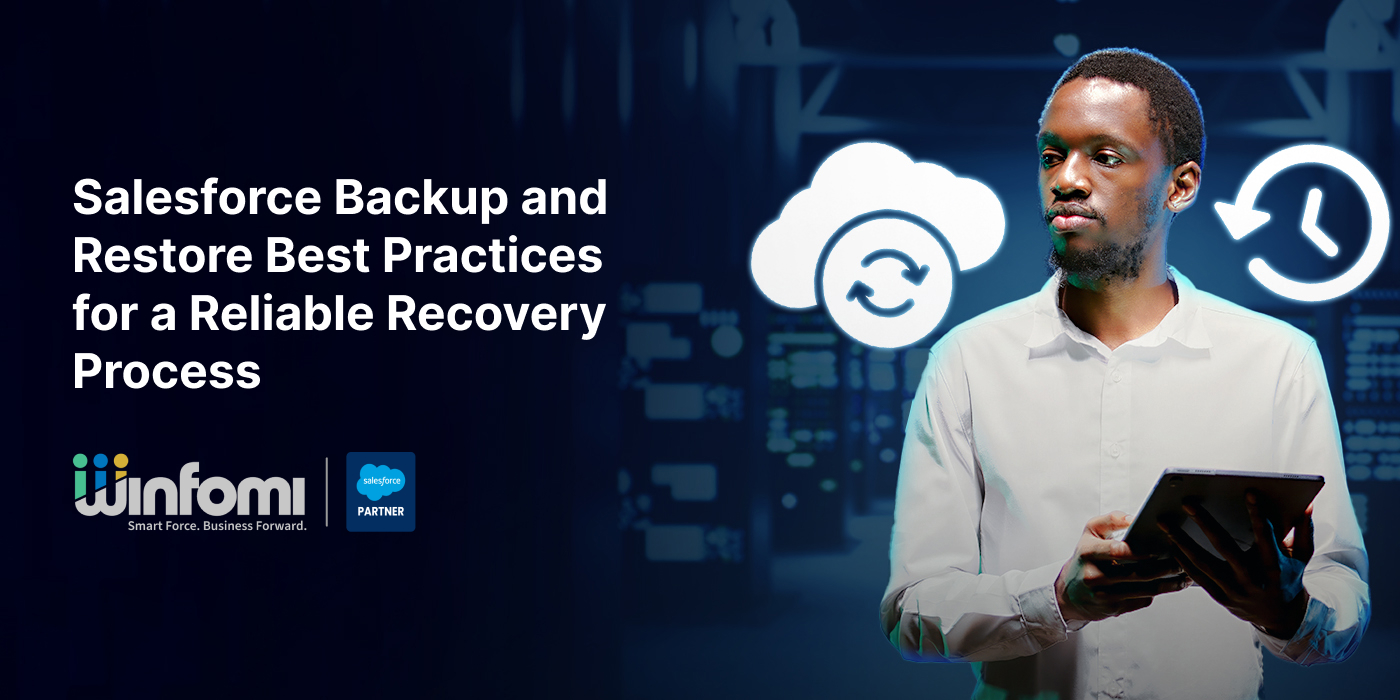

Share:
Table Of Contents
- Salesforce Backup and Restore Best Practices for a Reliable Recovery Process
- Have a Data Backup and Recovery Plan
- Assign Clear Responsibilities for Backups
- Automate Backups for Consistency
- Don’t Overlook Metadata Backups
- Keep Your Backups Compliant
- Store Backup Data Securely Off-Platform
- Secure Backup Data with Encryption
- Monitor Your Backup Data Actively
- Regularly Test Your Recovery Process
- Be Prepared for Different Data Loss Scenarios
- Implement Best Practices with a Third-Party Solution
- Ready to Protect Your Salesforce Org?
Salesforce Backup and Restore Best Practices for a Reliable Recovery Process
Backing up your Salesforce data is not just a technical necessity it’s the backbone of your business continuity plan. In today’s digital age, where data is the lifeblood of operations, having a robust backup strategy isn’t just an option; it’s a must. But setting up a backup solution and forgetting about it won’t cut it. You need a comprehensive, proactive approach that ensures your data is secure, compliant, and readily recoverable when the unexpected happens.
In this blog, we’ll walk you through ten best practices that will help you create a foolproof backup and recovery strategy. Whether you’re new to Salesforce or looking to refine your existing processes, these tips will ensure your organization’s data is protected and your recovery process is reliable.
Have a Data Backup and Recovery Plan
First things first create a clear and detailed data backup and recovery plan. This plan should outline who is responsible, the tools you’ll use, and the specific steps to take in case of data loss. But don’t stop there. Ensure this plan is well-documented and accessible to your entire team. Everyone involved should know exactly what to do if disaster strikes.
A well-thought-out plan not only keeps your team aligned but also minimizes downtime during a crisis. If you’re unsure where to start, consider Salesforce partners One on One Consultation.
Assign Clear Responsibilities for Backups
In any crisis, knowing who’s responsible for what is critical. Your Salesforce development team is often the go-to for data issues, but relying on a single person can be risky. Instead, assign a team to handle backups, ensuring there’s no single point of failure.
Empowering a team to collaborate on recovery without compromising security is crucial. For instance, using tools like Gearset, you can assign permissions based on roles allowing team members to view, edit, or fully restore backups as needed.
Automate Backups for Consistency
Manual backups are not only time-consuming but also prone to errors. If you’re relying on monthly backups, ask yourself: can your business afford to lose a month’s worth of data? Probably not. That’s why automated backups are essential. Aim to schedule backups at least daily to reduce your Recovery Point Objective (RPO) the maximum acceptable amount of data loss measured in time.
For most businesses, a 24-hour RPO is acceptable, but for critical data, you might need more frequent backups. Tools that offer on-demand backups, especially before major changes, can be lifesavers.
Don’t Overlook Metadata Backups
Your metadata is the blueprint of your Salesforce org. It’s what gives structure to your data, and without it, your data is like a ship without a hull unable to function or move forward. Therefore, backing up metadata is just as important as backing up data.
Ensure that your backup solution captures all necessary metadata types and that your data and metadata backups are synchronized. This way, when you restore, everything fits together seamlessly.
Keep Your Backups Compliant
Compliance is more than just a buzzword it’s a legal requirement. As regulations tighten, staying compliant with data management frameworks is crucial. Non-compliance can lead to hefty fines, operational disruptions, and even irreparable reputational damage.
Manual backup processes make compliance a challenge. Automated solutions like Gearset not only help you track backups but also offer audit trails and data retention features that ensure you meet regulatory requirements. For more on maintaining compliance, consider our Salesforce Data Backup Service, which includes compliance management as part of the package.
Store Backup Data Securely Off-Platform
Storing your backup data in the same place as your primary data is like keeping all your eggs in one basket. If something happens to the platform, both the original data and backups could be compromised. This is why it’s vital to store your backups off-platform, preferably in a different data center or cloud environment.
For example, Gearset uses Amazon Web Services (AWS) to store backups, ensuring that your data is not only encrypted but also stored securely away from your primary Salesforce instance. This is a fundamental best practice for Salesforce Data Backup.
Secure Backup Data with Encryption
Encryption is your first line of defense against unauthorized access. Within Salesforce, your data is encrypted both in transit and at rest, but it’s crucial to maintain these encryption standards when exporting and storing backups externally.
By using enterprise-grade encryption for your backups, you ensure that even if someone were to gain access, the data would be useless without the encryption key. This adds an extra layer of security to your Salesforce Data Backup.
Monitor Your Backup Data Actively
A backup is only as good as its last successful run. Regular monitoring is essential to catch any issues early. If something goes wrong with your data, the sooner you catch it, the quicker you can resolve it, minimizing business disruption.
Consider setting up smart alerts in Salesforce to monitor critical objects and changes. These alerts can help you detect unusual activity, so you can act before small issues become big problems.
Regularly Test Your Recovery Process
A backup plan is only as good as your ability to execute it under pressure. Regular testing at least every three months or after any major changes in your team is essential. Each test will reveal insights about what works and what doesn’t, allowing you to fine-tune your process.
Regular testing ensures that when a real incident occurs, your team can act confidently and effectively. The more you practice, the more seamless your recovery process will become.
Be Prepared for Different Data Loss Scenarios
No two data loss incidents are the same. Sometimes, you’ll need to restore large amounts of data; other times, it might be a single record or even just one field. Your backup solution should offer flexibility, allowing you to restore data selectively to avoid overwriting valid records.
For instance, Gearset’s recovery solution supports various workflows, whether you need a full-scale restoration or just a pinpoint recovery.
Implement Best Practices with a Third-Party Solution
Crafting a robust backup and recovery strategy might seem daunting, but it doesn’t have to be. By using a third-party backup solution, you can simplify the process while ensuring that all these best practices are covered. According to the State of Salesforce DevOps Report 2024, users of specialist backup solutions like Gearset reported the most consistent backups, quickest recovery times, and fewest data incidents.
Remember, while you can’t prevent all data loss, you can certainly minimize its impact. A solid strategy, combined with the right tools, can make all the difference. To learn more about protecting your Salesforce org, explore our Salesforce Data Backup services or Salesforce Data Backup for comprehensive solutions.
Ready to Protect Your Salesforce Org?
Book a free consultation with Winfomi today to discuss how we can tailor a backup and recovery strategy that suits your specific needs. Schedule your consultation now.






